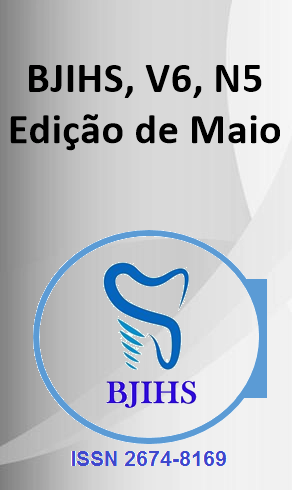Resumo
Os materiais restauradores têm se destacado na clínica odontológica, bem como os cimentos de ionômero de vidro, onde suas propriedades permitem que este material seja utilizado como restaurador, forrador e agente cimentante, pois é um material que apresenta propriedades como adesão à estrutura dentária. O presente estudo in vitro avaliou a microinfiltração marginal em cavidades classe III em coroas de dentes bovinos, restaurados com dois tipos de materiais restauradores: Cention N e Vitro Fil LC, através da avaliação da penetração de um corante fucsina violeta. Os resultados foram analisados através do teste de qui-quadrado, com nível de significância de 5% (P>0,708) concluindo que não há significância clínica entre os materiais restauradores.
Referências
MAZUMDAR, Paromita; DAS, Abiskrita; DAS, Utpal Kumar. Comparative Evaluation of Microleakage of Three Different Direct Restorative Materials (Silver Amalgam, Glass Ionomer Cement, Cention N), in Class II Restorations Using Stereomicroscope: An: In Vitro: Study. Indian Journal of Dental Research, v. 30, n. 2, p. 277-281, 2019.
HEPDENIZ, O. K.; ERMIS, R. B. Comparative evaluation of marginal adaptation and microleakage of low-shrinking composites after thermocycling and mechanical loading. Nigerian Journal of Clinical Practice, v. 22, n. 5, p. 633-641, 2019.
MENEZES-SILVA, Rafael et al. Mechanical and optical properties of conventional restorative glass-ionomer cements-a systematic review. Journal of Applied Oral Science, v. 27, 2019.
SUDHAPALLI, Sruthi Keerthi et al. A Comparative Evaluation of Microleakage among Newer Composite Materials: An: in vitro: Study. Contemporary Clinical Dentistry, v. 9, n. 4, p. 587-591, 2018.
SIDHU, Sharanbir K.; NICHOLSON, John W. A review of glass-ionomer cements for clinical dentistry. Journal of functional biomaterials, v. 7, n. 3, p. 16, 2016.
BALKAYA, Hacer; ARSLAN, Soley; PALA, Kanşad. A randomized, prospective clinical study evaluating effectiveness of a bulk-fill composite resin, a conventional composite resin and a reinforced glass ionomer in Class II cavities: one-year results. Journal of Applied Oral Science, v. 27, p. e20180678, 2019.
MISHRA, Abhishek et al. Comparative evaluation of mechanical properties of Cention N with conventionally used restorative materials—an in vitro study. Int J Prosthodont Restor Dent, v. 8, n. 4, p. 120-124, 2018.
MESHRAM, Priyatama et al. Comparative Evaluation of Microleakage Around Class V Cavities Restored with Alkasite Restorative Material with and without Bonding Agent and Flowable Composite Resin: An: In Vitro: Study. Indian Journal of Dental Research, v. 30, n. 3, p. 403-407, 2019.
BAHSI, E. et al. The evaluation of microleakage and fluoride release of different types of glass ionomer cements. Nigerian journal of clinical practice, v. 22, n. 7, p. 961-970, 2019.
CHUANG, Shu-Fen et al. Influence of flowable composite lining thickness on Class II composite restorations. OPERATIVE DENTISTRY-UNIVERSITY OF WASHINGTON, v. 29, p. 301-308, 2004.
UNNIKRISHNAN, Surej; KRISHNAMURTHY, Navin Hadadi; NAGARATHNA, C. Krishnamurthy. Marginal microleakage of glass ionomer cement with two different cavity conditioners on primary anterior teeth–an in vitro study. Indian Journal of Dental Research, v. 30, n. 2, p. 267-272, 2019.
UPADHYAY, Sumitha; RAO, Arathi; SHENOY, Ramya. Comparison of the amount of fluoride release from nanofilled resin modified glass ionomer, conventional and resin modified glass ionomer cements. Journal of dentistry (Tehran, Iran), v. 10, n. 2, p. 134, 2013.
CORRÊA, Luis Gustavo Pessoa; OGASAWARA, Tsuneharu. Estudos comparativos de alguns cimentos ionoméricos convencionais. Matéria (Rio de Janeiro), v. 11, p. 297-305, 2006.
GORSETA, Kristina; GLAVINA, Domagoj. Thermo-cured glass ionomer cements in restorative dentistry. Journal of Istanbul University Faculty of Dentistry, v. 51, n. 3 Suppl 1, p. 122-127, 2017.
HASAN, Ammar MHR; SIDHU, Sharanbir K.; NICHOLSON, John W. Fluoride release and uptake in enhanced bioactivity glass ionomer cement (“glass carbomer™”) compared with conventional and resin-modified glass ionomer cements. Journal of applied oral science, v. 27, 2019.
SILVA, Raphaela Juvenal da et al. Propriedades dos cimentos de ionômero de vidro: uma revisão sistemática. Odontologia Clínico-Científica (Online), v. 9, n. 2, p. 125-129, 2010.
SHAFIEI, Fereshteh; AKBARIAN, Sahar; ETMINAN, Mohammad Karim. Effect of adhesive pretreatments on marginal sealing of aged nano-ionomer restorations. Journal of Dental Research, Dental Clinics, Dental Prospects, v. 9, n. 3, p. 144, 2015.
PAI, Swathi et al. Evaluation and comparison of stress distribution in restored cervical lesions of mandibular premolars: Three-dimensional finite element analysis. Journal of International Society of Preventive and Community Dentistry, v. 9, n. 6, p. 605-611, 2019.

Este trabalho está licenciado sob uma licença Creative Commons Attribution 4.0 International License.
Copyright (c) 2024 Débora Mioranza Vivan, Rafaela Piardi, Mariá Cortina Bellan, Adriano Bruzza, Luiza Bonezi Boff, Alexandre Conde, Daniel Galafassi, Juliane Pereira Butze, Marília Paulus
